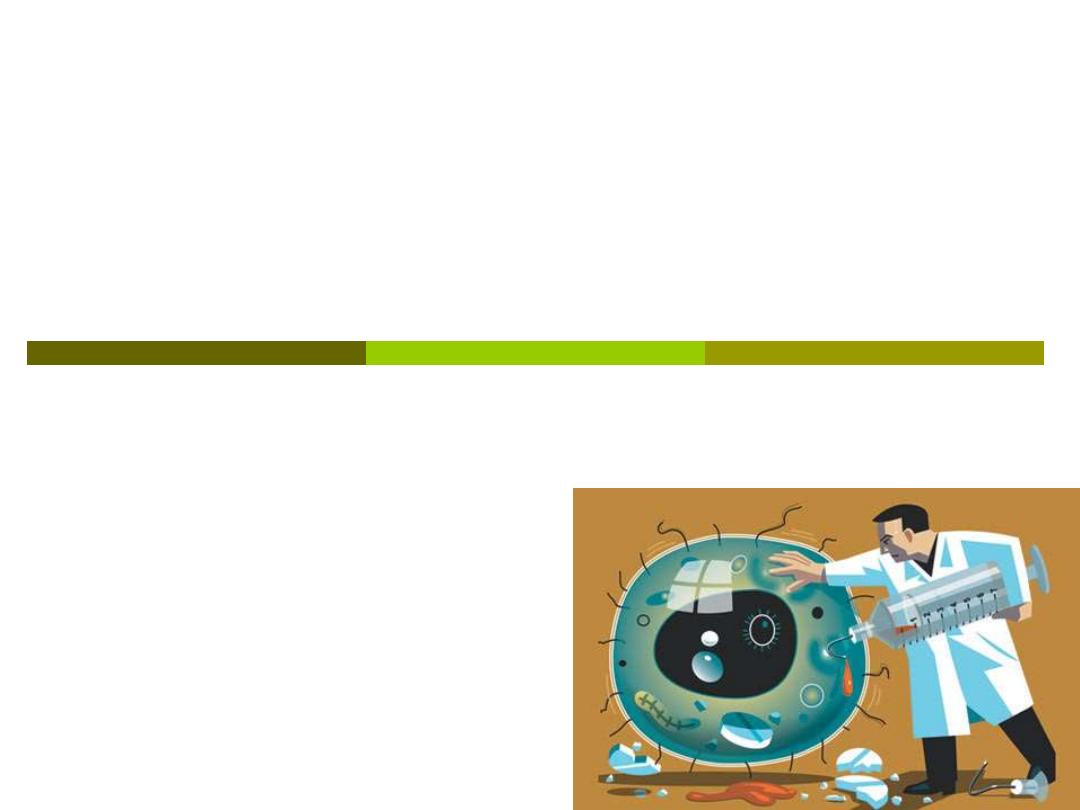
Antibiotic Resistance
Dr.Mohammad Alfaham
Microbiology

Introduction
Antimicrobial resistance (AMR) is the ability of
microorganisms that cause disease to withstand attack by
antimicrobial medicines.
The ability of pathogens that works against the antibiotics, is
termed Antibiotic Resistance.
Antimicrobials like antibiotics, antivirals, and others are losing
their effectiveness because of antimicrobial resistance.
Up to half of antibiotic prescriptions is unnecessary or
inappropriate.
If patients have a sore throat, the physician should take a throat
culture test. If the test results indicate that a bacterial infection
is present, then antibiotics should be prescribed to treat the
infection. There is no sure way of knowing whether a cold or
sickness is a bacterial infection without a test.

Evolution of Antibiotic Resistance
Antibiotic
Year Deployed
Resistance
Observed
Sulphonamides
1930s
1940s
Penicillin
1943
1946
Streptomycin
1943
1959
Chloramphenicol
1947
1959
Tetracycline
1948
1953
Erythromycin
1952
1988
Vancomycin
1956
1988
Methicillin
1960
1961
Ampicillin
1961
1973
Cephalosporins
1960s
Late 1960s

Common causes
1. Overuse
Physicians
Incorrect diagnosis and Prescribing Antibiotics for Viral (Seasonal Flu)
infections, 2 or more antibiotics together, unnecessary long courses of
antibiotics
Kills Resident Bacterias (Normal flora)
Some are survived
Antibiotic resistant genes
Passing of these genes to Pathogenic bacterias
Antibiotic resistance

Common causes
2. Misuse
Patients
Not finishing full course of antibiotics
Misuse
Leaving 1 or 2 doses
Some bacteria not killed
Resistance developed for future antibiotic treatment

Common causes
3antibiotics
Antibiotics
Available as OTC medicines
Inappropriate use
Overuse or Misuse
Antibiotic resistance

Common causes
4. Healthcare Workers
Hospital
Healthcare Workers
Not following infection control protocols
Resistance transferred by bacteria swapping genes

Common causes
5. Hospitalized Patients
Hospital
Patients with compromised health
Exposed to Pathogenic organisms
Increased usage of different antibiotics
Rapid development of Resistance

Common causes
6. Animal Feed
Animal feed
Mixed with antibiotics to prevent infections and to
promote growth
Resistant organisms in animals
Spread to Human

Common causes
7. Antibiotics in food and water
Antibiotics found in beef cattle, pigs and poultry
Drainage with antibiotics contaminates groundwater
Same antibiotics mixed with municipal water systems
we get antibiotics in our food and drinking water
promote bacterial resistance.

Common causes
8. Antibiotic resistance in genetically modified crops
Antibiotic-resistance genes
Inserted into the plant in early stages of development to detect
specific genes of interest e.g. herbicide-resistant genes or
insecticidal toxin genes
They are not removed from the final product
Antibiotic-resistance genes could be acquired by microbes in the
environment

Types of Resistance
1. Natural or inherent resistance
2. Mutational resistance
3. Acquired (Extra chromosomal) resistance
Natural or inherent resistance
Bacteria may be inherently resistant to an antibiotic.
Examples:
1. An organism lacks the target of the antibiotic molecule
Amino glycosides are resistant in strict anaerobes due to the absence of
an adequate transporter which leads to impermeability of drug
2. The cell wall of gram-negative bacteria, is covered with an outer
membrane that inhibits the entry of the antibiotic.
3. E.Coli contains AcrE as Multidrug efflux system and P.aeruginosa
contains MexB.
4. Klebsiella contains AmpC cephalosporinase for the inactivation of
antibiotic.

Types of Resistance
Mutational resistance
1. Target site modification (Mutation in rDNA genes
(rpsL) Streptomycin resistance) and change in PBPs (penicillin
binding proteins) ß-lactam resistance.
2. Reduced permeability or uptake
3. Metabolic by-pass (overproduction of DHF
(dihydrofolate) reductase or thi- mutants in S. aureus
trimethoprim resistance)
4. Derepression of multidrug efflux systems

Types of Resistance
Acquired (Extrachromosomal) resistance
1. Drug inactivation ( Enzymes like ß-lactamases,
aminoglycoside-modifying enzymes and chloramphenicol
acetyltransferase inactivate the antibiotics.)
2. Efflux system (Tetracycline is pumped out by efflux
pumps)
3. Target site modification (Erm methylases, methylates the
23S component of the 50S ribosomal subunit which leads to
resistance)
4. Metabolic by-pass (DHF reductase enzyme becomes
resistant and causes trimethoprim resistance).

Mechanisms of Bacterial Resistance
1. Enzymatic degradation of the drug
2. Modification of the drug's target
3. Reduced permeability of the drug
4. Efflux pumping of Antibiotics
5. Modification of Target ribosomes
6. Alteration of Pathway

Mechanisms of Bacterial Resistance
Enzymatic degradation of the drug
Beta lactamase (Penicillinase)
Breaks Beta lactam ring of penicillins and cephalosporins
Inactivation of drugs
Resistance to Beta lactam antibiotics

Mechanisms of Bacterial Resistance
Modification of the drug's target
Bacteria (MRSA)
Induces mutation of gene coding for target proteins
Changing of the structure of target
Resistance
Methicillin Resistant Staphylococcus Aureus (MRSA) is a very
dangerous pathogen and it develops the resistance by this
mechanism. It is resistant to antibiotics like Beta lactams,
Carbapenems, etc.

Mechanisms of Bacterial Resistance
Reduced membrane permeability
Bacteria
Reduces the production of Porin and other membrane channel protein
Reduction of the permeability of membrane
Drugs (Antibiotics) can’t pass through membrane to kill bacteria
Resistance
Bacterias develop resistance against Chloramphenicol by reduced permeability
of bacterial cell membrane.

Mechanisms of Bacterial Resistance
Efflux pumping of Antibiotics
Bacteria
Produces specialised membrane proteins which act as pumps
Pump out antibiotics
Reduction of antibiotic concentration
Resistance
Efflux pumps are active against the antibiotics like Tetracyclines (Greatest
activity), Beta lactam antibiotics and Flouroquinolones.

Mechanisms of Bacterial Resistance
Modification of Target ribosomes
Bacteria
Modifies ribosomal RNA
Inhibition of therapeutic activity of antibiotic
Resistance
Bacterias develop resistance against Amino glycosides
(Streptomycin) by the mutation of protein in 30S ribosomal
subunit
.

Mechanisms of Bacterial Resistance
Alteration of Pathway
Bacteria
Alternative metabolic pathway which can’t be inhibited by antibiotics
Inhibition of therapeutic activity of antibiotics
Resistance
Bacterias develop resistance against Sulfonamides (Trimethoprim) by this
mechanism.

Consequences of Antibiotic
Resistance
In a recent study, 25% of bacterial pneumonia cases were
shown to be resistant to penicillin, and an additional 25% of
cases were resistant to more than one antibiotic.
Drug-resistant bacteria is responsible for about 25,000 human
deaths annually in Europe.
Increased costs associated with prolonged illnesses, including
expenses for additional tests, treatments and hospitalization,
and indirect costs, such as lost income.
Investment in antibiotic development is discouraged, due to…
1. The development of resistance
2. The pressure to reduce the use of antimicrobials
3. The weak market incentives
4. Increasing difficulty and cost to develop new effective
antibiotics.

Possible Solutions for Antibiotic
Resistance
Stop unnecessary antibiotic prescriptions.
Finish antibiotic prescriptions.
Use the right antibiotic in an infectious situation as
determined by antibiotic sensitivity testing.
Use antibiotics in rotation.
Use combination of antibiotics if necessary.
Promote Vaccine recommendations.
Implement infection control measures, such as hand
washing, isolation precautions, and immunization.
Develop new effective antimicrobials or alternatives for
treatment.
Cooperate with international partners to contain the risks of
AMR.
Improve monitoring and surveillance of antibiotic use in
humans and animals.
Promote research and innovation.
Improve communication, education and training.


